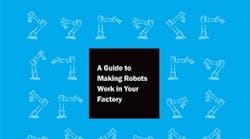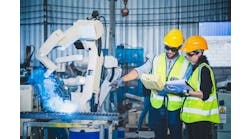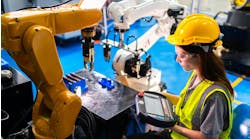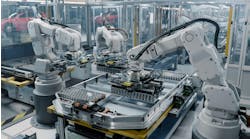Email [email protected] or browse to robotiq.com.
"The root cause of slow robotic adoption is the cost and complexity," says Samuel Bouchard, CEO at Robotiq. "I hear this often when visiting factories and talking to manufacturing personnel while trying to sell robotic technologies. However, the biggest roadblock is complexity. If we can make it simpler, the end users can do it on their own, and they can have a more cost-effective solution and better ROI. They can also deploy more robots and build their skills."
How can these things be simplified? "We reduce the complexity and increase the customer's skills, which can increase the adoption or robotic technologies," he says. A methodology called Lean Robotics was created to help the manufacturing engineer. It includes some free online tools and templates, as well as a cloud app to help to get robots on the plant floor.
Having plug-and-play products is part of the solution, and having a standard methodology to deploy robots is also important. "The only thing that doesn't change between the hundreds of factories I have visited is that they are all different," says Bouchard. "Although the robot application and mounting stand, table or fixture may be different, there can be a standard robot methodology."
The real world doesn't allow standardization of everything, but a standard methodology is the place to start when using robots in automation, continues Bouchard. "A great example of this is the 40 robots—eight five-robot teams—displayed at the Robotiq Users Conference in September 2017, which all assemble the same product, but each team of robots does it differently. There are many different ways to implement robots."
Follow the Robotiq User Conference via live blogging at blog.robotiq.com.
Robotic skills are new to manufacturing-process experts. "Our Lean Robotics book, released at the users conference, pulls skills locked in the heads of robot experts and presents them as a standard methodology that breaks a big problem into a step-by-step process," says Bouchard. "It is not just answering the question, 'Can I put a robot there?' The questions should be, 'What is the process as it is today?' forgetting about the robot. Then the robot concept is developed, and risks and differences are reviewed and addressed. In the end, you will still need some engineering, such as fixture development and programming, but understanding the overall process and how to manage it leads to successful deployment of robots in the factory."
The book is about the methodology, defining the steps of the process. Not only does it help the first-time robot user, it also shows how to scale robots across the factory. Robots, just like computers, are a horizontal technology; they can be used many places in a factory in applications such as machine tending, assembly and shipping. It's a transformative technology. Lean Robotics is available online at www.leanrobotics.org, and a Kindle version is also available.
The book covers how to go from design to integrate to operate, and do it efficiently, says Bouchard. “We created a software product suite to provide a set of online tools to help define robotic cell development.” It includes all of the tools to apply the methodology.
Whether you do it by yourself or with system integrators, it’s important to understand the beginning of the process. "New robot automation will need to match the manual process, while evaluating different robotic technologies," says Bouchard. "That's why we created Blueprints. It's an online app used to map a plant’s manual process, help to develop effective designs and have different groups collaborate on the project."
ALSO READ: The keys to robot selection, safety and collaboration
The tools also include a Skills application, which provides building blocks for an application. "In many cases there is no need to redesign the wheel," says Bouchard. "The Skills application speeds design, development and programming of a Universal Robots robot. It's just another layer, in this case software, on top or our plug-and-play hardware.
“We also created Insight, which is used at the end of the project once the robot is in operation,” continues Bouchard. "It's important to measure the real results of robotic automation. It measures the productivity of the robots, which enables an automation engineer to make continuous improvements to the robotic cell, based on the results. Insight is free to monitor basic robot functions and is available as a monthly service to store and view detailed robot production information."
Get your robot automation methodology set. Then use Blueprints to decide what and how to automate your processes. Download some Skills to add to your technical capabilities. After robot deployment, use Insights to improve production.







